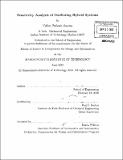| dc.contributor.advisor | Paul I. Barton. | en_US |
| dc.contributor.author | Saxena, Vibhu Prakash | en_US |
| dc.contributor.other | Massachusetts Institute of Technology. Computation for Design and Optimization Program. | en_US |
| dc.date.accessioned | 2011-03-24T20:23:35Z | |
| dc.date.available | 2011-03-24T20:23:35Z | |
| dc.date.copyright | 2010 | en_US |
| dc.date.issued | 2010 | en_US |
| dc.identifier.uri | http://hdl.handle.net/1721.1/61899 | |
| dc.description | Thesis (S.M.)--Massachusetts Institute of Technology, Computation for Design and Optimization Program, 2010. | en_US |
| dc.description | Cataloged from PDF version of thesis. | en_US |
| dc.description | Includes bibliographical references (p. 137-140). | en_US |
| dc.description.abstract | Many models of physical systems oscillate periodically and exhibit both discrete-state and continuous-state dynamics. These systems are called oscillating hybrid systems and find applications in diverse areas of science and engineering, including robotics, power systems, systems biology, and so on. A useful tool that can provide valuable insights into the influence of parameters on the dynamic behavior of such systems is sensitivity analysis. A theory for sensitivity analysis with respect to the initial conditions and/or parameters of oscillating hybrid systems is developed and discussed. Boundary-value formulations are presented for initial conditions, period, period sensitivity and initial conditions for the sensitivities. A difference equation analysis of general homogeneous equations and parametric sensitivity equations with linear periodic piecewise continuous coefficients is presented. It is noted that the monodromy matrix for these systems is not a fundamental matrix evaluated after one period, but depends on one. A three part decomposition of the sensitivities is presented based on the analysis. These three parts classify the influence of the parameters on the period, amplitude and relative phase of the limit-cycles of hybrid systems, respectively. The theory developed is then applied to the computation of sensitivity information for some examples of oscillating hybrid systems using existing numerical techniques and methods. The relevant information given by the sensitivity trajectory and its parts can be used in algorithms for different applications such as parameter estimation, control system design, stability analysis and dynamic optimization. | en_US |
| dc.description.statementofresponsibility | by Vibhu Prakash Saxena. | en_US |
| dc.format.extent | 140 p. | en_US |
| dc.language.iso | eng | en_US |
| dc.publisher | Massachusetts Institute of Technology | en_US |
| dc.rights | M.I.T. theses are protected by
copyright. They may be viewed from this source for any purpose, but
reproduction or distribution in any format is prohibited without written
permission. See provided URL for inquiries about permission. | en_US |
| dc.rights.uri | http://dspace.mit.edu/handle/1721.1/7582 | en_US |
| dc.subject | Computation for Design and Optimization Program. | en_US |
| dc.title | Sensitivity analysis of oscillating hybrid systems | en_US |
| dc.type | Thesis | en_US |
| dc.description.degree | S.M. | en_US |
| dc.contributor.department | Massachusetts Institute of Technology. Computation for Design and Optimization Program | |
| dc.identifier.oclc | 706821205 | en_US |
